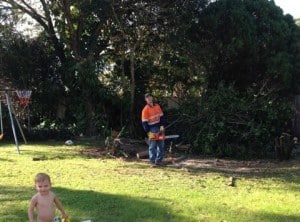I’m no tradie. But I do like to get in and have a go at some of the odd jobs that need doing around the house. In most cases, I get the job done and done well.
It wasn’t always that way. My introduction to DIY wasn’t ideal; it was about four years ago when several flat packs turned up at my door and I was charged with the task of turning these seemingly incongruous pieces of wood into something resembling nursery furniture. Armed with a couple of screwdrivers I found in the garage; I set about the job.
It wasn’t pretty. I finally got the job done but from that point on, I promised myself that I’d never feel so inept at DIY again. Over the years, I’ve spent a good deal of time learning basic carpentry skills (thanks to YouTube!) and I’ve amassed quite a collection of tools to make things a bit easier for myself around the home.
Recently we bought a home in our ideal location. The house and yard needed a bit of work and I felt up to the task. The first thing I set about doing was the backyard; a new fence, clearing and ripping out the old overgrown garden beds, working out what to do with the monstrous cactus growing over the garden shed, etc. I was enjoying the work until my old foe resurfaced: acute lower back pain.
And so, I’d like to share my story with you, and in doing so, help you, if you too are afflicted with back pain.

How it started
Lower back pain has been part of my life for many years. In my early 20s, while working in a furniture removal business, I slipped and fell, landing on my lower back.
The pain gradually intensified over the next few days to an excruciating level, making it impossible to do simple tasks like putting on my shoes and pressing the clutch in the work truck. Not only was the pain debilitating, but it was depressing too.
Here I was, in the prime of my life but unable to embrace it due to the ever-present pain in my back and legs.
I had the decision to make. I could endure the pain and live a life defined by my pain or I could do my best to discover the cause of the pain and find a remedy for it so that I could return to my usual healthy self. I chose the latter.
After a good many months of tests, it turned out that I had ruptured two disks in my lower back that were compressing nerves causing the severe pain.
After 14 months of physical therapy, corrective exercise, and an orthopedic surgeon telling me to get a job that required brain not brawn, I was back to my usual vibrant self.
During my recovery period, I realized I no longer wanted to work in furniture removal, so I took the surgeon’s advice and completed Certificate III & IV in gym instruction. It was then a natural progression to take my interest in physical well-being to the next level by completing a Bachelor of Clinical Science and a Master’s Degree in Osteopathic Medicine.
Back pain again
So after a good number of pain-free years, the pain was back.
About six months ago, I was getting rid of a heap of concrete from the backyard. Nothing could stop me; I was a lean, mean concrete shifting machine! But they say pride comes before a fall and the next morning, I couldn’t move.
The dreaded back pain from my past was back and to make matters worse, we were heading up north that afternoon to visit my wife’s family.
This pain recurrence I was experiencing is quite common for sufferers of back pain and the pain business. We call it an acute strain of a chronic injury. In my case, the strain came as a result of using poor lifting technique trying to get the job done quickly. Thankfully, this time around, I knew what to do.
How I fixed my back pain
I had a fair idea of what I had done and knew what muscles were in spasm. So, on the dining table of my in-laws’ place, I directed my wife to push on this and pull on that and within 48 hours, the pain had subsided down to a manageable level. I was then able to commence performing some corrective exercises and stretching and within another 48 hours the pain had all but gone.
Common causes of back pain
When it comes to back pain, the positive news is that in 90% of cases, the pain is attributed to non-specific causes. That means there is no serious pathology such as cancer, infection or fracture present that is causing the pain. Usually, you’ll find that it’s a simple strain done at a vulnerable time.
For example, you have been working hard all morning and at a time when you’re fatigued, you perform a lazy lift and strain your back. Depending on the severity of the strain, the recovery period will usually be between 1 to 13 weeks.
For a small number of sufferers, the pain can go beyond the expected healing time. That is when the pain becomes chronic or persistent. Chronic pain is a bit of an enigma; it’s not usually related to physical injury or damage and has more to do with thoughts, emotions and lifestyle behaviours.
Fearing back pain, high stress and anxiety, depression and low mood, as well as smoking and excessive alcohol consumption, can fuel chronic pain by making the nervous system highly sensitised. Eventually, sufferers find themselves stuck in a vicious pain cycle.
What you can do to minimise the risk of back pain
Nobody wants back pain, so here are a few ideas that will help you avoid it.
Be careful how you lift (Particularly when fatigued)
- Don’t bend over from the waist to lift heavy objects. This will compress your spinal discs and put them in a vulnerable position of being injured. Bend your knees and squat, pulling in your stomach muscles and holding the object close to your body as you stand up.
- Don’t twist your body while lifting. This weakens the integrity of the supporting ligaments making you more prone to an injury. If you can, push rather than pull heavy objects. Pushing is easier on the back.
- Be aware of your limitations. There is a big difference in what you think you can lift and what you can safely lift.
Sleeping habits
- Your mattress should be firm enough to support your body while supporting the weight of your shoulders and buttocks, keeping your spine straight. If your mattress is too soft, place a firm board – ideally, 2cm thick – on top of the base of your bed and under the mattress.
- Supported your head with a pillow but make sure that your neck is not forced up at a steep angle.
- Avoid sleeping on your stomach. Many stomach sleepers experience some form of back pain that can affect the length and quality of sleep. Furthermore, sleeping on your front places strain on your lower back and neck as well as forcing neck rotation in order to breathe.
- Try to sleep on your back with your spine supported or on your side with your knees slightly bent.
Exercise
- Exercise is an excellent way of preventing back pain as well as reducing the intensity of existing back pain. If you haven’t exercised regularly before or it’s been a long time since you have, you’ll have to consult your doctor or healthcare professional before starting any exercise program to rule out any red flag conditions.
- To make a difference, consistency is key. Exercise must become an everyday thing. It doesn’t have to be strenuous or for hours on end; you just have to get your body moving. Every. Single. Day.
- Low-intensity exercise such as walking or swimming, strengthen the muscles that support your back without straining or jolting it.
- Activities such as yoga, Pilates, and resistance training can improve the flexibility and the strength of your back muscles. It is important that you carry out these activities under the guidance of a qualified instructor.
This is for your education purposes only. This post cannot replicate or replace expert assessment and guidance from a health professional qualified to treat pain. If you want to go one step further Don’t just go to any health professional. Consult one who has a special interest in active solutions for back pain.



